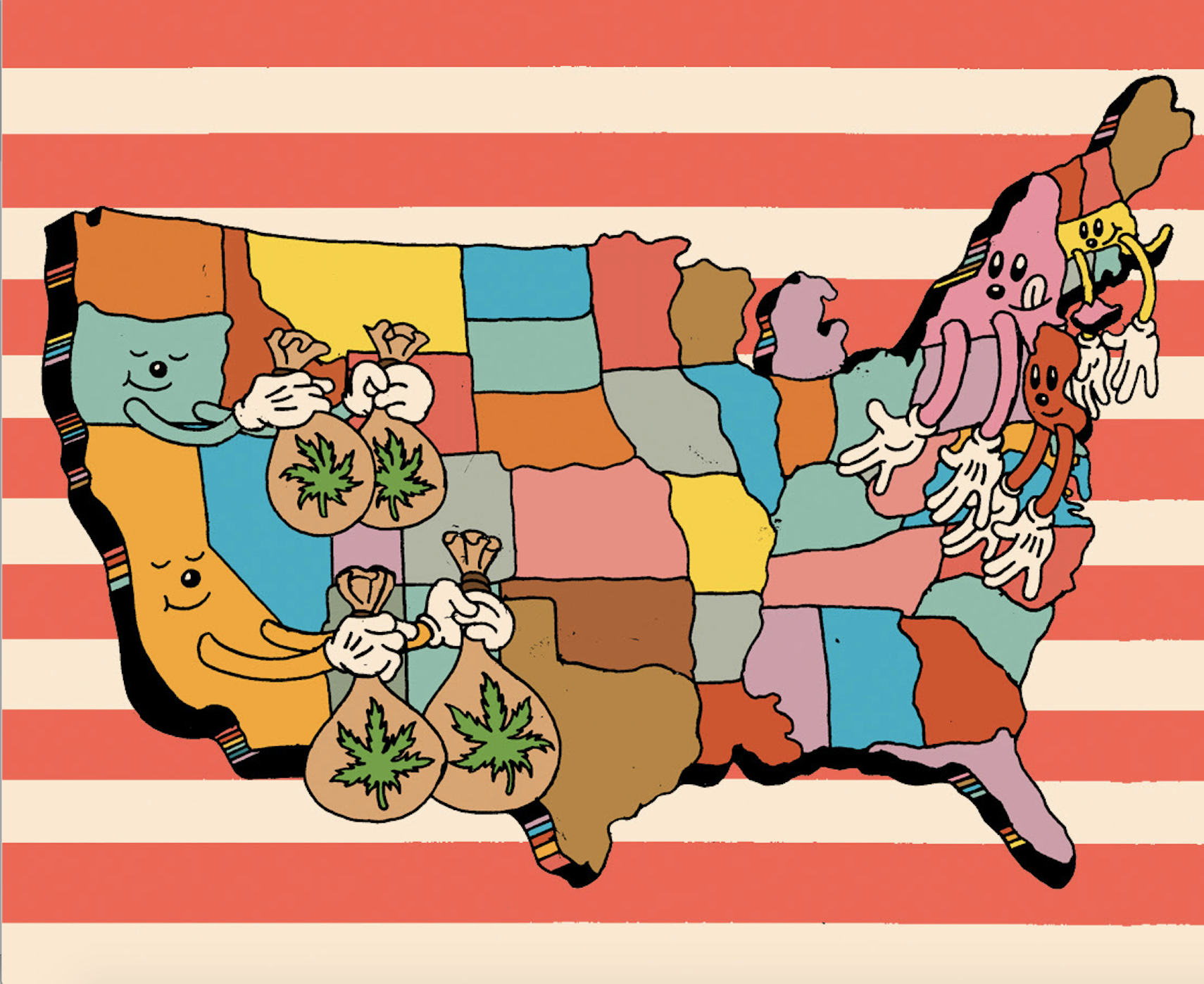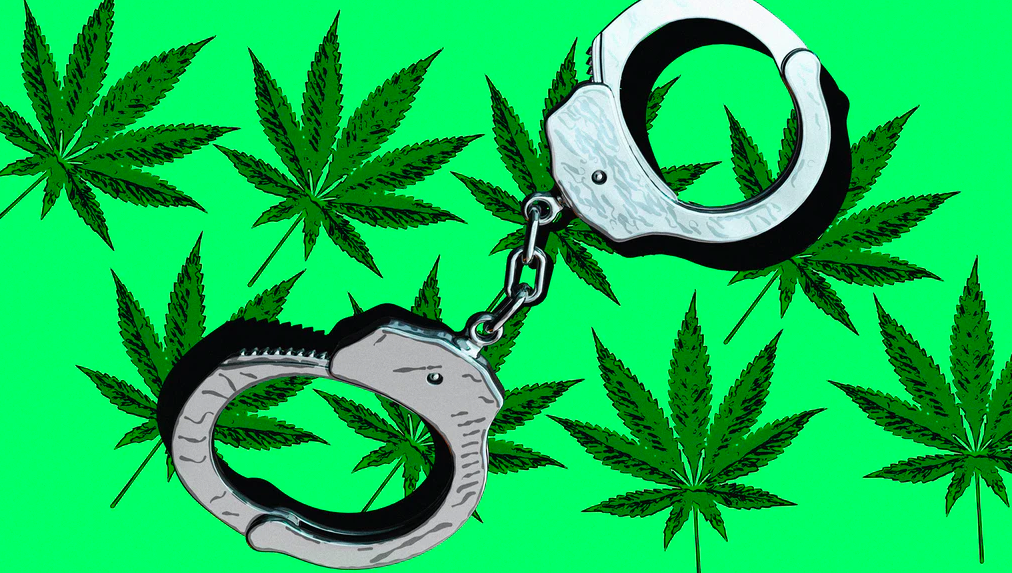Illustrations by Brian Blomerth
Is interstate commerce a key to social and economic justice in the cannabis industry?
Over the past several years, a debate about social equity has intensified as large consumer states with unconscionable histories of discriminatory drug law enforcement have moved towards adult-use cannabis legalization. How can we ensure that the economic benefits of legalization reach the people and communities most harmed by the War on Drugs? Is it possible, in a newly legal industry, to account for justice?
What if there were a way to turn the economics of the cannabis industry on its head in soon-to-be-legal states like New York, New Jersey, and Connecticut? What if, instead of handing huge profits to a few large corporations that are able to pour billions of dollars into wasteful and unsustainable cannabis production schemes in those states, we could put economic power into the hands of people and communities most harmed by a century of prohibition?
Perhaps we can.
.jpg)
The concept is simple. Traditional cannabis importing states, especially states with long histories of racially-biased criminalization and enforcement (basically all of them), should create a class of cannabis licenses that would allow licensees to import, distribute, and sell at retail cannabis from producer states like Oregon and California. And these licenses would only be available to qualified social equity applicants.
Under such a system, equity-licensed businesses — and only equity-licensed businesses — in large consumer states like New York and New Jersey could fill retail shelves with an unbeatable selection of the best cannabis products from legal markets around the country. And they could offer those products almost immediately upon their state’s legalization.
“This would alter the entire economic structure of the cannabis industry,” says Jason Ortiz, president of the Minority Cannabis Business Association (MCBA). “Those equity licensees wouldn’t just compete, they would dominate the industries in traditional import states. This concept promises economic justice at a much more significant scale than anything we’re currently discussing at the state level.”
.jpg)
Between 1994 and 2008, in New York City alone, more than 430,000 people were arrested for low-level cannabis offenses. And despite the fact that people of color are no more likely to use or sell cannabis than white residents, they accounted for more than 85% of those arrested. Flashforward a decade, and the data is no different. In the first half of 2019, New York City police made 805 fifth-degree cannabis possession arrests, and 94% of those arrests targeted were people of color. The story differs only in scale in cities and states across the nation, as millions of mostly young people of color have, for decades, been cuffed and booked for marijuana offenses at rates more than four times that of white people.
The cumulative damage that millions of discriminatory arrests have done to the educational, employment, and housing prospects of generations of people of color cannot be addressed by simply expunging criminal records or offering discounted licenses in newly legal markets. This is especially true when it’s clear that the economic gains of legalization would still go primarily to large corporations — unless another path is taken.
“Some people exploit the social justice piece of legalization,” Bertha Lewis, president of The Black Institute and a chief strategist for activist group We Rise to Legalize, told the New York Times. “You can’t talk to me about justice and not talk to me about economics. They are inextricably joined.”
So last year, with New York State on the verge of legalizing adult-use cannabis, legislators of color stood up to demand real equity for their communities.
“They thought we were going to trust that at the end of the day, these communities would be invested in,” Lewis continued. “But that’s not something I want to trust. If it’s not required in the statute, then it won’t happen.”
Governor Andrew Cuomo, whose administration authored New York’s failed 2019 legalization bill, is himself on record demanding that legalization in New York account for the discriminatory history of cannabis enforcement.
“Let’s stop the disproportionate impact on communities of color, let’s create an industry that empowers the poor communities that paid the price and not the rich corporations that come in to make a profit.”
~ New York Governor Andrew Cuomo, via
.jpg)
Envisioning, much less constructing, a system and an industry with significantly equitable economic impacts has proven difficult. Governor Cuomo’s bill faltered, due in large part to doubts among legislators of color that their communities would gain significant benefits from legalization. Illinois subsequently passed a legalization bill that included unprecedented racial equity provisions. But as important an achievement as that was, its provisions will not significantly change the underlying economic equation.
As long as states where cannabis is difficult to grow are forced to cultivate all of their own weed, economic power will remain in the hands of a few large corporations that can afford to invest tens or even hundreds of millions of dollars in massive, mostly indoor production facilities.
But if large consumer states like New York and New Jersey were to create a class of equity-only licenses that allowed holders the exclusive right to import, distribute, and sell high-quality, low-cost cannabis from traditional producer states like Oregon and California, it would lay the foundation towards a very different outcome.
And it would force governors like Andrew Cuomo (NY) and Patrick Murphy (NJ) to add their powerful voices to the growing chorus calling on the federal government to allow — or at least tolerate — commerce in cannabis under interstate agreements between legal markets.
It could be game changing.
.jpg)
The movement for interstate commerce began out west, where most of America’s cannabis, and virtually all of its finest cannabis, has always been grown. In June of this year, Oregon passed legislation allowing the state to enter into interstate agreements to buy and sell cannabis. To become operable, the bill requires that the federal government either allow such transfers via federal statute, or else simply express “tolerance” of the practice in a Department of Justice memo or policy statement indicating that they will not use federal resources to prosecute businesses transporting cannabis between legal markets under interstate agreements.
In July, in response to the passage of the Oregon bill, the State Cannabis Commerce Act was introduced by Rep. Earl Blumenauer (D-OR) and Senator Ron Wyden (D-OR) in both the US House and Senate. The Act would forbid federal agencies from interfering in state legal cannabis industries, and specifically protects licensed interstate commerce. By permitting interstate commerce in statute, the bill would satisfy the either/or federal requirement contained in the Oregon bill.
The federal bill is important for several additional reasons. It is the first federal bill to contemplate interstate commerce prior to full federal legalization. It also places the issue of interstate commerce in the context of protecting the legal state industries, which is essential. We cannot support functioning state legal industries unless we allow them to move cannabis from markets where there’s excess capacity to markets where there’s excess demand. Because that’s how healthy markets function. Finally, even if Congress does not pass the bill, the concise, specific language forbidding federal interference in licensed interstate commerce could be adopted into any legislation that moves forward protecting state industries from federal interference.
In 2020, California legislators will consider an interstate commerce bill similar to the one passed in Oregon this year. Should that bill pass, two of the nation’s best and most important cannabis-producing states will be joined in a call to normalize licensed interstate transfers between states in the legal US market.
It’s clear why states like Oregon and California would want to sell their legal cannabis into the markets they have supplied illicitly for generations. Between 2017 and 2018, for example, Oregon faced a tremendous cannabis glut, as the bounty of the production region far outpaced the relatively tiny Oregon consumer market. This resulted in a price crash and a ton of business failures. Today, that problem has been temporarily addressed by growers artificially ramping down production during the past two growing cycles, as well as a continued squeezing of local producers.
But there are also plenty of reasons — economic viability, environmental sustainability, patient access, consumer choice — for traditional cannabis importing states to demand interstate access to the best cannabis that legal producers can supply.
In most US states, where high-quality outdoor cultivation is difficult or impossible, it’s environmentally irresponsible and economically unsound to invest billions of dollars to grow cannabis at scale. And it will take years to license and ramp up that type of production into a viable retail market. Legal interstate commerce would not only fill shelves, it would move millions of consumers out of illicit markets years sooner than would otherwise be possible.
In many medical states, where legal cannabis production is limited or non-existent, “legal” patients — who are currently risking their health on unknown and untested products from the illicit market — would instantly have access to a broad selection of tested, dependable, world-class medicines to meet their specific needs.
In addition, before we watch tens of billions of dollars invested in production capacity across the country, we must keep in mind that once federal prohibition ends, it will no longer be possible for states to keep other states’ products out. This means that all of those in-state producers will suddenly have to compete with better, cheaper cannabis from places far better suited to grow it. When that happens, many state-based production industries will go belly-up entirely, wiping out capital, companies, and jobs.
But none of these reasons for allowing licensed, interstate trade may be as compelling as the chance to make significant amends for the historic, discriminatory harms of prohibition.

“Our black and brown communities have paid an enormous price for the political obsession with looking ‘tough on crime,’” says Jason Ortiz of the Minority Cannabis Business Association. “I was one of those people who was demonized and arrested, and now we’re looking at entire communities that were violently disrupted for economic activities that are making foreign corporations billions. If anyone is going to make a living selling cannabis legally, it ought to be the folks who have been aggressively denied that opportunity in the past.”
And make no mistake, giving equity applicants the exclusive right to import would create a substantive advantage.
“It will take years for giant corporations to build and stand up enough production capacity to fill shelves in states like New York or New Jersey,” says Jesse Peters, co-founder of Oregon’s Eco Firma Farms, and now CEO of Mantis Growth Investments. “When they do, it will be almost impossible for them to compete on cost, particularly with outdoor producers, and especially on biomass for oil extraction, which is a significant and growing part of the market. More than that, it will be extremely difficult for their output to compare in quality to what Oregon and California produce every day.”
The world class outdoor cannabis production region of the Pacific Northwest stretches more than 500 miles from the “Emerald City” of Eugene, Oregon, south to the bottom of California’s famed Emerald Triangle (Mendocino, Trinity, and Humboldt counties). This region, generally considered one of the best, if not the best, grow areas on the planet, has historically produced the vast majority of America’s domestic cannabis.
That’s no accident.
“This is one of the very best, and certainly right now the single most important, cannabis-producing region in the world,” says Eric Sklar, CEO of Fumé Brands, and a co-founder of Alpha Omega Winery in Napa, CA. “We have always grown a lot of cannabis here, because this is where it grows best.”
“It’s no different than the wine industry,” Sklar continued. “You can grow grapes in various parts of the country, and some of it isn’t bad, but the meta-wine producing region of the Pacific Northwest is world class. Nowhere else in the country even comes close. We have the right climate, the right soil types, high-quality water, and an unbeatable combination of genetic and human capital. It’s the same with cannabis.”
The illicit cannabis market in the US has always flowed from west to east. Products move from where they are best produced to where they’re most in demand. No one had to be told to set it up that way. Again, that’s just how markets work.
“We’ve spent the past two years talking about how to achieve racial equity — justice, really — as we legalize cannabis in huge consumer states,” said Khurshid Khoja, the National Cannabis Industry Association’s Policy Council Co-Chair and Board Member. “However, we’ve been assuming it as a given that everything consumed in a state must be produced there. But that’s a by-product of prohibition, and it’s not how healthy markets function. That’s not how the cannabis market in the US has ever worked, which is why self-contained state markets are inherently more turbulent.”
Last month, the governors of New York, New Jersey, Connecticut, and Pennsylvania met to discuss legalizing cannabis in the region. Together, they concluded that building entirely different systems right next to each other would lead to problems, including the inevitable criminal arbitrage that will occur when prices and availability vary widely on every side of every state border. In the end, they said, the only sensible solution is to work together to reach common policies on key issues including tax rates, testing and labeling requirements, and how to create industries that address the very real issues of social and economic justice.
In January, the legislatures in each of those states, and likely several others, will again take up the issue of legalization.

After a century of prohibition created with specific racist intent, ramped up into a “War on Drugs” in the ‘70s, and brought to new lows in the ‘80s and ‘90s era of “Just Say No,” cannabis enforcement has had disastrous consequences — particularly for communities of color. Now, as we contemplate the end of this terrible chapter of our history, and as state after state renounces prohibition, there is both an opportunity and a responsibility to think creatively about how to do so in ways that account for, and are accountable to, the systemic harm done in its name.
Of the millions of young people of color arrested for cannabis over the past half-century in states like New York, New Jersey, and Connecticut, virtually none were arrested for growing their own marijuana. That’s not what they were doing. Instead, they were arrested for distribution, sales, and possession of cannabis that came from elsewhere, mainly Oregon or California. Legal or otherwise, cannabis in the US naturally moves west to east, from the hills of the Pacific Northwest to Northeastern cities and everywhere in between.
Perhaps the best way to achieve racial and economic equity is to recognize that reality, and start from there.
For more on Adam J. Smith, follow @OurCraftFuture on Twitter and Instagram, and visit the Craft Cannabis Alliance website











